
Posts Tagged: Macrophomina
I Have a Diagnosis of Macrophomina or Fusarium in My Strawberry Field – Now What Do I Do?
Accompanying the current spate of Macrophomina and Fusarium discoveries by the UCCE Diagnostic Laboratory in Salinas and by other pathologists, growers, farm managers, and PCAs are now faced with the question of what the next step should be.
Fumigation: The advice for growers and farm managers is to avoid bed fumigation at this juncture. Even beds fumigated by professional operators will have little reservoirs of surviving pathogens on the shoulders where the fumigant did not travel. Of great concern are pathogen populations surviving in the soil making up the untreated furrows. Growers who are not flat fumigating with methyl bromide + chloropicrin should consider using a high rate of chloropicrin under impermeable film. This likely will not be as good a treatment as the mix of methyl bromide + chloropicrin used in the past, but it is the next best soil treatment solution.
Reducing stress to the plants: The diseases caused by both Macrophomina and Fusarium develop earlier, more rapidly, and more severely if plants are stressed. Strawberries that are under-chilled or subject to irrigation deficits, fertility shortfalls, and/or pest issues (such as mites) can succumb fairly rapidly, while those perfectly managed can withstand disease for a longer time. Growers wanting to reduce their diseases losses from here on out will need to play a tight defensive game and address plant stress factors in a timely manner.
Not disturbing the existing bed: The in-field spread of both Macrophomina and Fusarium is mainly accomplished by tillage and other procedures that move soil around. Because neither pathogen makes airborne spores (such as those made by powdery mildew and gray mold pathogens) or swimming zoospores found in soil water (produced by Phytophthora), the spread of inoculum is only by physical movement of the soil. Presumably, beds remaining intact and in place, as they would be for second year strawberries or other system of minimal tillage, will keep the pathogen from being spread to non-infested parts of the field.
This situation has been observed locally. In 2013, a strawberry field had significant Macrophomina outbreaks in certain parts of the field. Held over for a second year, the dead areas were replanted and again developed disease in those sections; however, second year plants that were healthy in 2013 were mostly healthy in 2014. While growing second year strawberries is not being recommended, this type of situation demonstrates the key role of soil movement in disease epidemiology.
Sanitation: Sanitation is critical for limiting the spread of Macrophomina and Fusarium. Tractors, tillage equipment, and irrigation pipes moving from infested fields should be cleaned. Remember too that a strawberry field that had significant dieback two years ago and is now planted to lettuce or another crop, likely still has plenty of Fusarium or Macrophomina around. It is a good practice for all of us to pay attention to where we have been and clean up if you are coming out of an infested field.
Having the Right Attitude and Accept the Changing Reality: In this environment of new diseases and reduced to no availability of good fumigants, those able to keep open minds and adopt new practices stand the best chance to weather the storm from these new pathogens. Growers and agricultural professionals of all stripes MUST adapt to this new era. Go to meetings, keep up to date on the latest research, talk with reputable professionals and be ready to make the changes necessary to keep your crop the most productive it can possibly be.

Photo progression- Field with Macrophomina June 21. Photo by Steven Koike, UCCE.
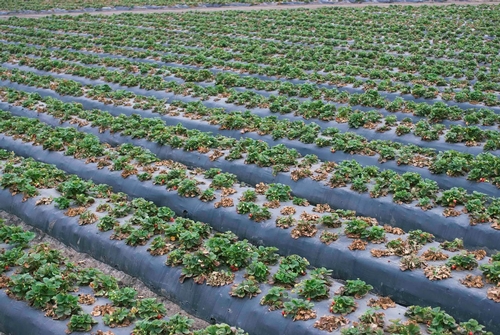
Photo progression - same field as above with Macrophomina- July 5. Photo by Steven Koike, UCCE.

Photo progression - Same field as above with Macrophomina July 26. Photo by Steven Koike, UCCE.
Charcoal Rot of Strawberry: Increasing Problem in California
Beginning at least as early as 2005 and continuing through 2013, collapsing strawberry plants from various parts of California have been associated with the soilborne fungus Macrophomina phaseolina. The disease, called charcoal rot, appears to be the most important current concern for the industry due to its steady increase over this period of time. Each year finds additional new fields infested, and the disease has now been found in all of the major strawberry producing counties in the state. In 2005-2006, charcoal rot was restricted to southern California in Orange and Ventura counties. Most recently this disease has been confirmed in Santa Barbara, Monterey, Santa Cruz, and Santa Clara counties. The spread of Macrophomina to new fields and counties portends that charcoal rot may be a long term threat to the industry which at present does not have satisfactory plant resistance with which to combat the pathogen.
Symptoms of Macrophomina infection in strawberry consist of wilting of foliage, plant stunting, and drying and death of older leaves, with the central youngest leaves often remaining green and alive. Plants can eventually collapse and die (Figure 1). When plant crowns are cut open, internal vascular and cortex tissues are dark to orange brown (Figure 2). Disease is often most severe if the infected plant is subject to stresses such as weather extremes, water stress (shortage of water), poor soil conditions, or heavy fruit loads. In locations where the disease has occurred for more than one season, the patches can be quite large and appear to have spread from the initial problem area (Figure 3). Such patterns are consistent with the spread of a soilborne pathogen. It is noteworthy that in these cases we have never isolated other important, well known pathogens such as Colletotrichum, Phytophthora, or Verticillium. However, it is important to note that another recently described disease, Fusarium wilt, is also occurring in the same regions; symptoms of Fusarium wilt are identical to those caused by charcoal rot.
Macrophomina produces numerous tiny, black, irregularly shaped microsclerotia (Figure 4). These microsclerotia are survival structures that allow the fungus to persist for extended periods in the soil. The fungus is spread within and between fields mostly by the transport of contaminated soil during soil tillage and preparation operations. Spread of Macrophomina in strawberry fields deals with the same issue of field sanitation that concerns growers of many other commodities. Verticillium wilt (lettuce, strawberry, pepper), clubroot (broccoli, cauliflower), Fusarium wilt (lettuce), Fusarium yellows (celery), and lettuce dieback disease (lettuce) are all problems caused by soilborne pathogens that are spread in infested soil.
Current management strategies involve the following: (1) Crop rotation. Do not plant strawberry in fields having a known history of the problem and avoid back-to-back strawberry plantings in infested locations. (2) Pre-plant fumigation. This remains a useful tool for managing Macrophomina and the other soilborne pests, even though bed-applied fumigants may not provide complete control. (3) Avoid stressing the plants. Stress will hasten the development and increase the severity of symptoms, so use appropriate growing and irrigation practices to reduce stress. Note, however, that even in the absence of stress, infected plants will eventually develop the disease. (4) Sanitation. Growers with Macrophomina infested fields need to be concerned with limiting the spread of the fungus from infested to clean fields.

Figure 1. Charcoal rot results in the collapse and death of strawberry plants. Photo Steven Koike, UCCE
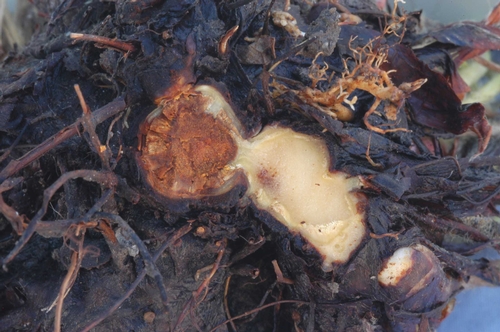
Figure 2. Internal crown tissue of strawberry infected with Macrophomina will show a dark to orange brown discoloration. Photo Steven Koike, UCCE

Figure 3. Charcoal rot can affect large portions of a field and cause significant dieback. Photo Steven Koike, UCCE
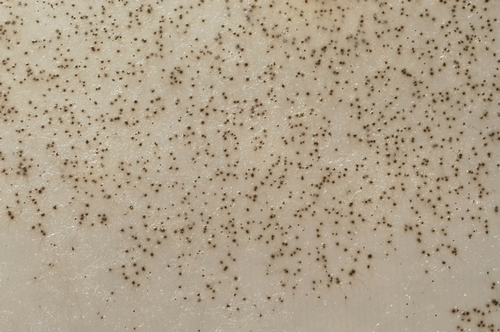
Figure 4. Tiny, black microsclerotia enable the Macrophomina pathogen to survive in the soil. Photo Steven Koike, UCCE
Third Macrophomina Find in Watsonville- Salinas Production District
A big field of strawberries in Santa Cruz County has been confirmed as being infected with Macrophomina phaseolina. This is the third confirmation of this disease in the Watsonville- Salinas production district. Long time readers of this space will know that the first confirmed find was two years ago which interestingly is in close proximity to this latest situation.
Symptoms of this disease, known as charcoal rot or crown rot, are marked by plant stunting, initial wilting of older foliage, and the drying and death of outer leaves (Photo 1 below). Similar to a plant infected with Verticillium, the central leaves will remain green and alive for a period of time. However, in contrast to most Verticillium infections which show little to no discoloration of the crown when cut open, a plant infected with Macrophomina will show a distinctive dark brown to orange brown discoloration of the crown (Photo 2 below). Eventually, plants infected with Macrophomina will collapse and die.
What is notable about this particular field is the astonishing distribution and severity of the infection (Photo 3 and 4 below) even though the field was flat fumed with methyl bromide- chloropicrin every other year for more than a decade. It is presently a mystery to researchers how this infection reached this magnitude so quickly.
A grower with a Macrophomina infested field should take action to limit the spread of the fungus. Any sort of tillage of an infected field should be followed by a thorough washing with water to remove soil clods and trash which are all potential carriers of the pathogen. Finally, to attempt to clean up Macrophomina from strawberry fields, pre-plant flat fumigation with methyl bromide/ chloropicrin provides the best control.
What about rotating to a non-host crop? This is actually a difficult question to answer. Macrophomina has a broad host range and is reported as a pathogen of many vegetable, fruit, and field crops. Rubus, the genus of caneberries, has not been reported as a host, but that does not necessarily mean such plants would never be infected. Still, it is too early to know for certain whether Macrophomina from strawberry can infect other hosts. Some researchers have successfully infected strawberry with Macrophomina from other hosts, but not the other way around. Our UCCE team is conducting research to answer these and other questions about Macrophomina in California fields.
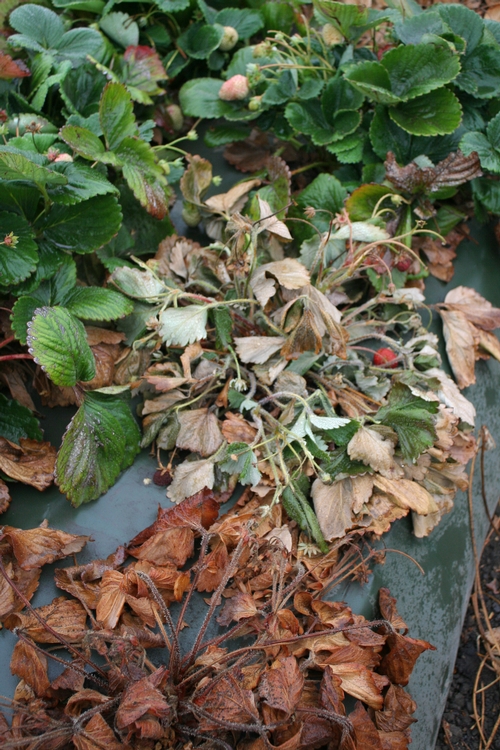
Close up of Macrophomina induced dieback.
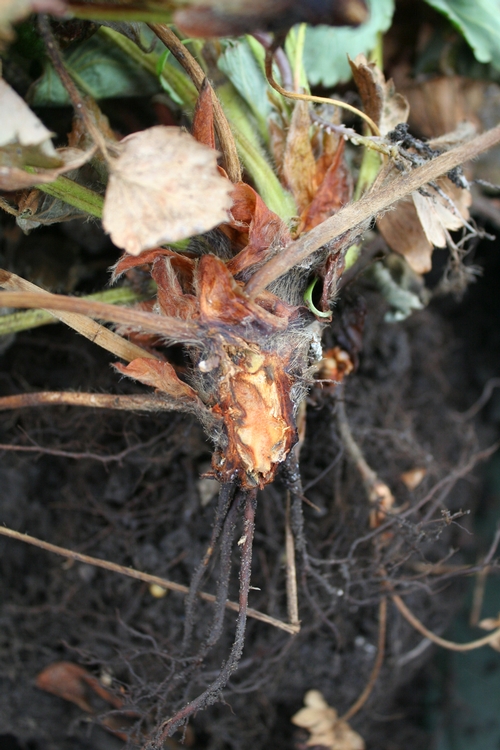
Discolored crown typical of Macrophomina infection.

Overview of dieback in field.

Large dead area caused by Macrophomina infection.
